It’s time for my annual hummingbird migration post, for fall migration is definitely underway! Whether you live up north or down south, you can help hummingbirds fuel up for travel. Here are tips to help them do so safely, all the while enjoying all you can of these fun little birds.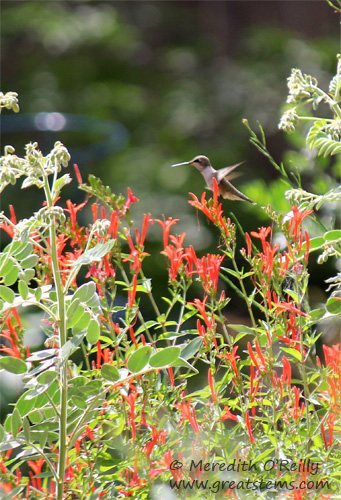
Hummingbirds love a variety of native nectar plants, such as Flame Acanthus above, but they will readily go to feeders as well. I provide both, and often I’ll see a hummer go back and forth between blooms and feeders’ sugar-water. If you don’t already have native plants to offer, go ahead and plant some (here in Texas, fall planting is the best time to plant). In the meantime, get a feeder outside to start attracting hummers to your yard.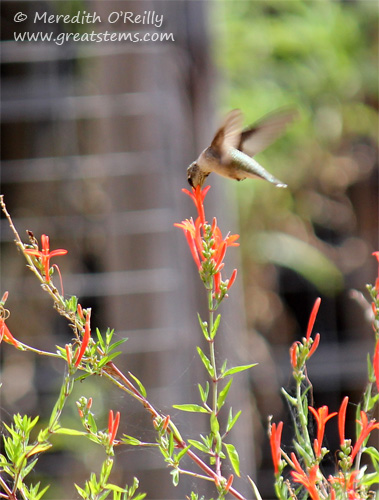
One of the reason I love Flame Acanthus is that it blooms despite the summer heat and despite our Texas drought. When the hummingbirds need it most, it provides. It also has two features hummingbirds love: tubular blooms and a red color. That doesn’t mean hummers won’t visit blooms that are flat or other colors — what they love is nectar, and while they might more frequently visit the classic red blooms, they’ll visit many other flowers as well.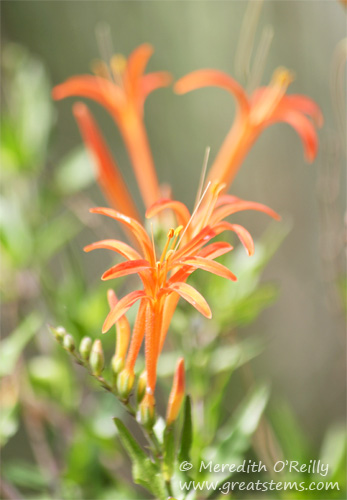 I have Flame Acanthus in two colors — red and orange. Other native Texas plants I grow for hummingbirds include Turk’s Cap, Standing Cypress, Autumn Sage, Tropical Sage, Crossvine, Coral Honeysuckle, Red Yucca, Texas Lantana, Purple Coneflower, Yellow Bells/Esperanza, Texas Betony, Lindheimer’s Morning Glory, and more.
I have Flame Acanthus in two colors — red and orange. Other native Texas plants I grow for hummingbirds include Turk’s Cap, Standing Cypress, Autumn Sage, Tropical Sage, Crossvine, Coral Honeysuckle, Red Yucca, Texas Lantana, Purple Coneflower, Yellow Bells/Esperanza, Texas Betony, Lindheimer’s Morning Glory, and more.
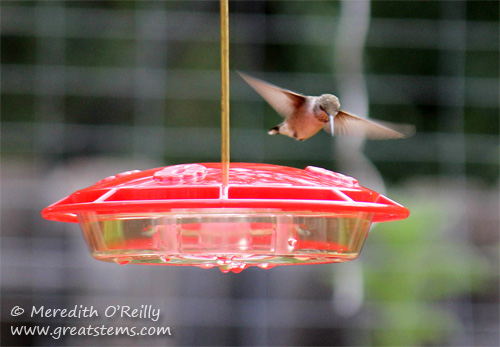 But I always have feeders out, even in the winter. For a variety of reasons a hummingbird might not be able to migrate as far as it is expected to, and having a feeder available when no blooms are present in winter just might save its life.
But I always have feeders out, even in the winter. For a variety of reasons a hummingbird might not be able to migrate as far as it is expected to, and having a feeder available when no blooms are present in winter just might save its life.
The following recipe is the standard for safe hummingbird nectar: 4 parts water to 1 part white table sugar. Don’t use food coloring or another additive, and do not use turbinado, raw sugar, honey, or brown sugar. Some people boil their sugar-water first, and that’s fine.
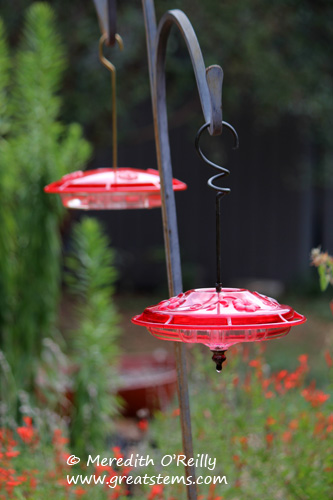 When selecting a hummingbird feeder, I look for three primary things — does it only show red (no white or yellow parts), is it made of plastic or glass, and is it easy to keep clean? I avoid feeders with white or yellow flowers because bees are attracted to these colors, and I avoid metal feeders because they can so easily rust, and the heavy iron can kill hummingbirds.
When selecting a hummingbird feeder, I look for three primary things — does it only show red (no white or yellow parts), is it made of plastic or glass, and is it easy to keep clean? I avoid feeders with white or yellow flowers because bees are attracted to these colors, and I avoid metal feeders because they can so easily rust, and the heavy iron can kill hummingbirds.
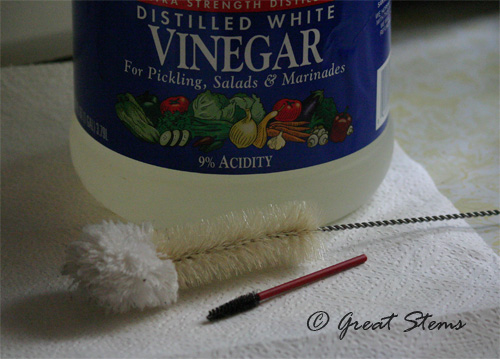 Cleaning feeders regularly is vital to hummingbirds’ health. I replace the sugar-water every 3 days, scrubbing out the feeders with a vinegar wash and small bottle brushes. If you don’t have a tiny brush for the little holes, try a pipe cleaner. Be sure to include any little nooks and crannies, hunting down and scrubbing any black growth. Don’t let your feeders get yucky!
Cleaning feeders regularly is vital to hummingbirds’ health. I replace the sugar-water every 3 days, scrubbing out the feeders with a vinegar wash and small bottle brushes. If you don’t have a tiny brush for the little holes, try a pipe cleaner. Be sure to include any little nooks and crannies, hunting down and scrubbing any black growth. Don’t let your feeders get yucky!
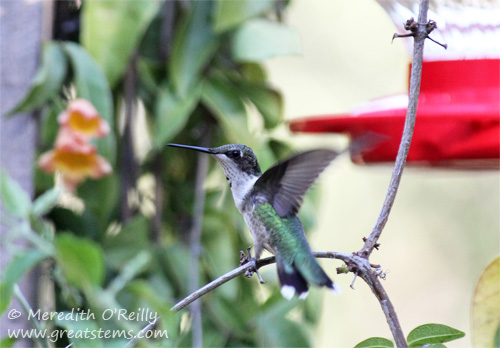 How else can you help our little hummer friends? Keep your garden free of pesticides, for hummingbirds need insects and spiders for protein. They’ll eat aphids, fruit flies, midges, and even mosquitoes! They also love shallow running water and mists.
How else can you help our little hummer friends? Keep your garden free of pesticides, for hummingbirds need insects and spiders for protein. They’ll eat aphids, fruit flies, midges, and even mosquitoes! They also love shallow running water and mists.
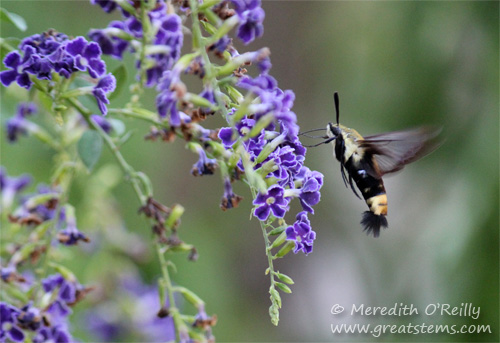 Of course, don’t be fooled if some other “hummingbirds” come to visit — this little Snowberry Clearwing Moth has well earned its nickname of Hummingbird Moth. It flies and hovers and zips about to feast on the nectar of daytime-blooming flowers. You might do a double-take, for it can look like a hummingbird if you catch just a glimpse.
Of course, don’t be fooled if some other “hummingbirds” come to visit — this little Snowberry Clearwing Moth has well earned its nickname of Hummingbird Moth. It flies and hovers and zips about to feast on the nectar of daytime-blooming flowers. You might do a double-take, for it can look like a hummingbird if you catch just a glimpse.
Happy hummingbird migration! If you live north, don’t fret — these little beauties are going to refuel in the warmer winter regions and will be on their way back to you in just a few months!
Great stuff Meredith — what plant is in the last photo of the clearwing moth? Are there any types of feeders that are better at keeping ants out?
Alan, some of my feeders have ant moats built in, but you can also get an attachment ant moat that can go above a regular feeder — you fill it with water so that ants can’t crawl to reach the main part of the feeder. However, I don’t typically worry about little sugar ants — I figure the hummingbirds can use a little protein if they accidentally lap one up with their tongue, haha. Fire ants haven’t been interested, thank goodness. The plant in the last photo is a Duranta, Golden Dewdrop — it’s not a native, but it’s doing well and the butterflies and hummers are enjoying it.
I always learn so much from your posts, Meredith. I learned about the rust issue from one of your previous hummingbird posts, and today I learned about the yellow/white parts attracting bees! I’ve seen hummingbirds feed on zinnias – now that was a surprise! The flame acanthus is by far their favorite in my garden.
Caroline, when I grew zinnias a few years ago, the hummingbirds loved them! I guess they are great nectar providers. One of these days I’ll sprinkle out some more seeds. The last time, the rain came and washed all my zinnia seeds into one area — sigh.
What beautiful shots!
Hummingbirds are so photogenic, aren’t they? 🙂 I wish I were!
Great post. I particularly liked the description of the color of hummingbird feeders – ONLY red. I just this year learned that lupines (including the Texas bluebonnet.) Add that red dot to make the entrance to the flower’s nectar invisible to bees. It keeps the bees from visiting fertilized flowers because bees don’t see red.
So bees can’t see the feeders if they are red. I should have been able to figure that out, but hadn’t till now. Thanks for your help.
I can’t guarantee that bees won’t go to red feeders, just that they are less likely to, and more likely to easily notice the feeders that have white or yellow flowers. There are other factors that can attract them, I’m sure — perhaps just spilled sugar water would do the trick. Plus some feeders have a bit of an orange tinge, so they could potentially still be noticed. Regardless, I can tell you that I’ve never had a bee or wasp issue at any of my red feeders.
A wonderful post, Meredith! Our hummingbirds seem to prefer the Fuchsia, although I do have a feeder ready for them. It’s a blue globe feeder, and the bees love it, too. 🙁 But I also have Zinnias on the side of the house–so hopefully they’re getting some nectar there, too. Gorgeous shots!
I bet they are, PlantPostings. I recall hummingbirds loving Zinnias. Bees see blue — I bet that’s one reason they are loving your feeder. Hopefully, the hummers are timing it well so they avoid the bees!
What great photos of those hummingbirds…they are so much fun to watch.
They are fun — always entertaining!
We’ve had such fun with our little hummers this Summer.They’ve gone crazy over the Black and Blue Salvia. I don’t usually put up a feeder but when I did a couple of weeks ago, I captured some great shots of one little guy trying to figure it all out.: “Mamma Told Me There’d be Days Like This”. Alas they have left for their Migration south… and I’m sure missing them.
Carolyn, I definitely didn’t have the same numbers this year as I had last year, but I still had enough to be happy. They are already transitioning south, however, so we are only getting passersby now. Well, spring will be here before we know it!